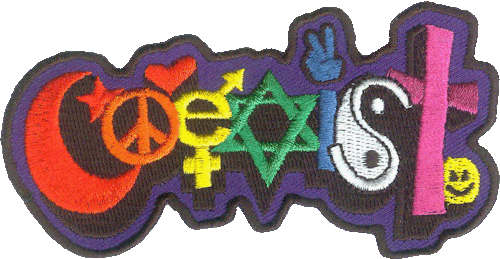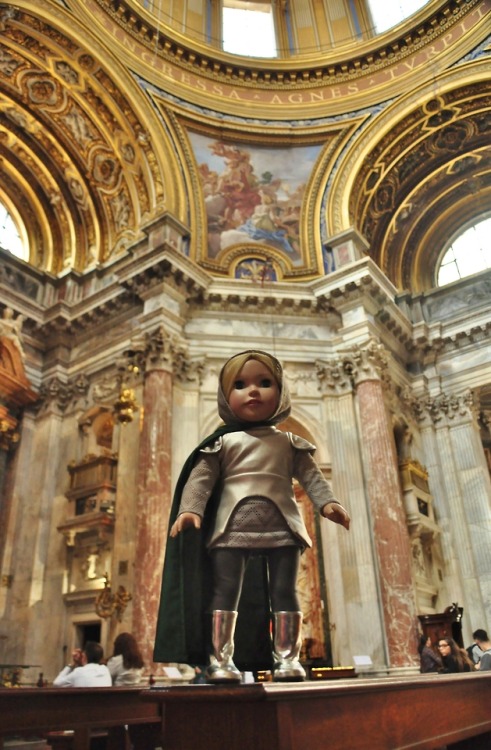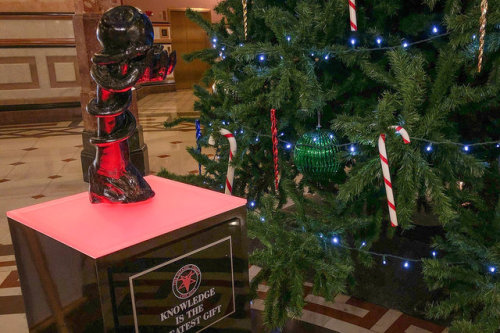#religions
If your spirituality runs on blind hatred, whether of a religion or a group of people, then you’ve got some serious work to do on yourself, because spirituality out of hate is not spirituality.
Putting up advertising below a billboard for the Church of Scientology, Shibuya, Tokyo, Japan. Friday January 13th 2017
Photo © Damon Coulter
Post link
To all the Nicks….
Saint Nicholas
Name Day
December 6th
TheEastern Orthodox Church, the Roman Catholic Church, and the Anglican Churches (taken together, representing a quarter of humanity) celebrate Saint Nicholas every year on December 6, which is the name day for “Nicholas”.
InGreece, the name and its derivatives are especially popular in maritime regions, as Saint Nicholas is considered the protector saint of seafarers….for more than a millennia.
No wonder I have salt water in my veins! My ancestors came from seafaring towns in central and southern Greece….dating back centuries. I’m drawn to the sea….

“Nicholas” in Greek means, literally, victory of the people.
The name became popular 1,700 years ago through Saint Nicholas, Greek Christian Bishop of MyrainLycia (today’s southern Turkey). Nicholas was famous for his generous gifts to the poor….with the name and the legacy evolving many centuries later, to become the Dutch/German (my Mom’s heritage, by the way) inspiration for Santa Claus – a derivation of “Saint Nicholas.”
For all my brethren named “Nicholas,” December 6 is a day to celebrate, on par with your birthday. It’s a day to reflect on all the good things you bring to family, friends and community. It’s a time to stand tall and proud: you’re a “Nicholas”! And, around the Holiday Season each year, you might even earn the affectionate moniker “Saint Nick”!
(My Dad, also ”Nicholas”, and I celebrated the day as far back as I can remember. It was our private bond. And it’s always been a deep honor to carry his name!)
* * * *
My Dad penned this poem early one December 6th morning, as he was sipping on his pre-dawn coffee in front of his computer. He gave it to me when I went over to my parents house for dinner that evening 17 years ago (to celebrate our shared Name Day)….(he passed away quite suddenly just a nine months later)….and the poem remains a priceless gift and treasure – loving inspiration from Father to Son – that will remain with me always. I think about it almost every day….and gain strength from it….as if it were a compass for this life-long mariner….

Post link
much in the same way as “history is written by the victors”, what is “secular” is determined by the dominant religion
“Our Faith Can Move Mountains!”-Matthew 17:20 St. Joan of Arc’s inspiring life was a testament to this verse, putting all her faith in God and freeing the French People! Dollsfromheaven.com
Post link
I have so many passions I’m not able to actually pursue any of them.
I want to learn about consciousness but I want to learn about the placebo effect in the brain but I want to learn about ancient cultures but I want to learn about history of art but I want to learn about religions but I want to learn about architecture but I want to learn about philosophy but I want to learn about quantum mechanics but I want to learn about cosmology but I want to learn about the brain.
Anonymous asked:
Hi, I want to write a book that is mainly set in a North Indian inspired country. The stories plot revolves around the perversion in organized religion and I wanted to have the belief system be monotheistic and resemble a more western faith. Can North Indian cultural resemblance coincide with a western inspired belief system?
Using a South Asian culture and religion without systemic privilege in western society to demonstrate problems in western organized religion seems insensitive at best. It could possibly coincide if you wanted to talk about predatory evangelical practices in some underdeveloped countries, however this would also be an iffy subject considering that South Asian Christian communities are oppressed in Pakistan, India, and Bangladesh.
Additionally, in India, the majority religion is Hinduism. It is not monotheistic.
Sikh conceptions of god are the closest to panentheism in academic terms, and some western academics call it monotheistic. However Sikhi is an oppressed religion in both South Asia and the West. Do not base the belief system on Sikhi.
Islam is an oppressed religion in India and the West. Do not base the belief system on Islam.
If you want to write about the issues within organized religion in “western faiths,” then write about western faiths in their respective countries. If you mean “white evangelical Christianity, then write about “white evangelical Christianity.”
- SK
If you are trying to show the perversion of Western-inspired organized monotheistic religion, why would you choose a region of the world that is known for polytheism in their religious traditions? Think about why you chose North India for your country’s basis, and your personal bias relating to North India. For that matter, North India has a variety of traditions and religious adherence across the states–try to specify and find a particular state, or even a particular city, to focus on. It will make your research much more targeted and effective.
Remember that the religious beliefs of a particular region are entwined with the local culture; motifs in art, architecture, literature, etc. will usually have references to a region’s particular organized religion and mythology. Substituting in a monotheistic religion to a culture shaped by polytheistic/pantheistic tradition is going to leave you with gaps in your world that can’t be fully explained away in a narrative considering these issues.
There are examples of ‘monotheism’ that are native to India; some regions particularly worship one major deity and view the others as lesser to their chosen deity. Others come closer to panentheism, as SK said, or even a sense of philosophical atheism. However, the influence of Western-inspired monotheism, which I’m going to call ‘evangelical Christianity’ as SK stated previously, came with colonialism and the intentional subjugation of the native faiths.
Reference the following posts for a little more background on that:
- Drawing inspiration for Magic from Disparate Sources: Hinduism, Māori culture, and Japanese Buddhism
Using India, or any of South Asia, as a way to demonstrate the problems with Christianity/pseudo-Christianity/any of the other Abrahamic faiths would be ingenuine to both the existing traditions of these faiths and the region you’re trying to insert them into. On the surface, it seems like you want to take the elements of a different culture that looks pretty to you, and use them to contextualize an issue that you feel strongly about personally.
The best-case scenario, if you were to continue with this idea, would involve heavy coding on both sides, and the reconciliation of monotheism with a cultural background that isn’t based on monotheism. It would take a colossal amount of work for anyone to do this justice, with respect to the culture of origin. You would have to essentially remove or explain away many of the cultural elements that are integral to properly writing/coding a North-Indian inspired society. This would probably take away from your main point about the corruption of organized faith, unless you can manage to create a loosely-inspired religion that can still achieve the message you are trying to get across. With that comes extensive work in worldbuilding, coding, potentially conlanging, etc.
You need to think about why you chose a region that is known for not being monotheistic in order to reflect the problems of organized monotheistic faith. The best solution, at this point, is coming up with a different setting, preferably one that didn’t face colonization and religious assimilation. Also, think about why you chose to portray the flaws of organized monotheism in the first place.
~ Abhaya
We were all just humans at one point, a point that may now seem far too distant to exist again. We were all just human before humanity drove a wedge in itself and began to divide us. We were all just humans before race drew lines that defined us. We were all just humans before socioeconomic status classed us. We were all just humans before religion split us, before politics polarized us. Now we are lines, lines that should not not crossed, labels that cannot not be ripped off and groups from which ones own they should not venture. We are white or black, Muslim or Christian, Republican or Democrat. I dream of a day when we are labels no more, a world where we are more than what we are called and the lines that once divided us are begging to be crossed. I dream of a life for our children where instead of a white christian and a black atheist we are all once again just human. I believe only then will the world know true peace.
Post link
I was raised to mind certain traditional beliefs (which is what I assume you mean by Native American religion) and our family also participated in Native American Church (NAC [not what I assume you mean by NA religion]) and we also have a lot of relatives, including my dad who were boarding schooled and indoctrinated with Christian religions.
Keeping in mind that Native American religion and traditions are not homogenized or monolithic, but as a general theme, Indigenous beliefs are usually meant to explain the world around us, teach us to respect our bodies, and teach us about our own respective histories. For example one of my tribes has a creation story that involves canoes; our land is surrounded by many lakes, so why and how this story was created is fairly obvious. Another creation story I was told a lot as a kid involved a turtle - turtles are one of our clan animals so this connection seemed obvious. I was taught our stories about why the sun is bright, why we bead, why we harvest rice, among other things. There is even a story about why we tell stories. Sometimes there are milestones and events within our life that call for ceremony, which is usually private and whose structure and tradition is passed down and overseen by our elders.
When I was a tiny tot, there were these really thick and really exciting (in the way anything unexplored is) woods near our house. We were told to stay out of the woods because of the little people and what these little people would do to us if they caught us. I was slightly skeptical until I went for a walk my aunt and we heard a blood-curdling shriek from the woods. ‘That’s the little people’ she told me. I never wanted to go near the woods after that (though I did spend a summer constructing elaborate traps with some friends). How cheated! I felt once I found out about possums and their unique shrieks and put two and two together - but I must say even knowing this and being much older and hopefully at least a bit more wise, I still pause before entering the woods and will often leave an offering especially if I am taking something out (like firewood) just because beliefs and traditions, like religions, can be hard to shake. Also, it’s not even an issue of ‘shaking’ one’s religion, sometimes it just makes sense to me. By pausing before I enter, by giving thanks and being grateful that I am able to take firewood, by doing these actions I am being mindful of my actions which is a helpful practice (at least for me).
Native American Church is a bit different. Our family refers to it as a ‘meeting’, some people call them peyote ceremonies, and they are usually what gets cheaply depicted in movies when they are stereotyping Indigenous cultures. We participated as a family when we were in off the reservation, and while the city we were is fairly large and diverse, finding other Natives can sometimes be difficult, let alone finding someone from your specific tribe. The closest reservation was a few hours away and whose traditions were quite different than ours. Contrary to popular myth, we don’t all know each other or get along. So we would end up at NAC as a way to convene with other Natives. I was pretty little and mostly remember the ceremony being very different than ones back on the rez. Not just the protocols and stories but the manner of how the ceremony is held is quite different. Even later as I have attended NAC on a few other reservations I find it different than my tribal practices, but there is a similarity regardless of reservation or tribe and that in of itself can be comforting. Even at Azee Bee Nahagh meetings some of the songs I’ve heard were christian hymns. I would say these meetings are closer to the Western concept of religion than our actual tribal traditions and beliefs, but even then I don’t think an outsider would have an easy time following along if they were even allowed inside since paperwork can be required to attend.
I think it is also important to be aware that we didn’t even get the right to practice our own religion until 1978 (American Indian Religious Freedom Act) and even though the act passed - considering the many laws and policies that still prevented us from gathering or access to ceremonial objects - this is like cutting off our legs and telling us to run. There is also an entire bloody history of invasion and conversion that I won’t detail here but whose history is widely available online or just by looking around. My father was forced into a christian boarding school as a kid, as were many other relatives - so this is also going to factor heavily into traditional outlook. In 1993 the Religious Freedom Restoration Act was passed which further helped us gain access to objects used in ceremony - but again, these are major roadblocks and obstacles spanning years and thus preventing practice during those times. Even now it can be difficult to practice a religion when the things we keep sacred and revere are being carved up. The idea of having to produce paperwork and performing the ridiculous acrobatic routine that is filling out federal paperwork just to attend a ceremony can be tiring, frustrating, and upsetting.
npr:
In the Illinois Capitol rotunda this month, several traditions are being celebrated. There’s a Nativity scene for Christmas, a menorah for Hanukkah, and then something a little different: an arm holding an apple, with a snake coiled around it.
It’s a gift from the Chicago branch of The Satanic Temple. Called “Snaketivity,” the work also has a sign that reads “Knowledge Is The Greatest Gift.”
Nearby stands a sign in which the state offers a civics lesson — and explains it didn’t have much of a choice:
“The State of Illinois is required by the First Amendment of the United States Constitution to allow temporary, public displays in the state capitol so long as these displays are not paid for by taxpayer dollars. Because the first floor of the Capitol Rotunda is a public place, state officials cannot legally censor the content of speech or displays. The United States Supreme Court has held that public officials may legally impose reasonable time, place and manner restrictions regarding displays and speeches, but no regulation can be based on the content of the speech.”
Illinois Secretary of State spokesman Dave Druker toldThe State Journal-Record the temple has the same rights as religious organizations. “This recognizes that.”
The Satanic Temple calls itself a “non-theistic organization” in its application to install the display.
In a GoFundMe campaign to raise $1,500 for the display, the group explainsits mission: “The Satanic Temple—Chicago will no longer allow one religious perspective to dominate the discourse in the Illinois State Capitol rotunda during the holiday season. … Please consider what you may do to help us bring Satan to Springfield!”
Satanic Sculpture Installed At Illinois Statehouse, Just In Time For The Holidays
Image: Brian Mackey/NPR Illinois 91.9 UIS
Post link










